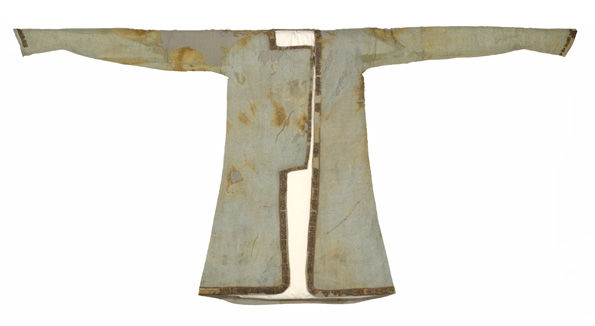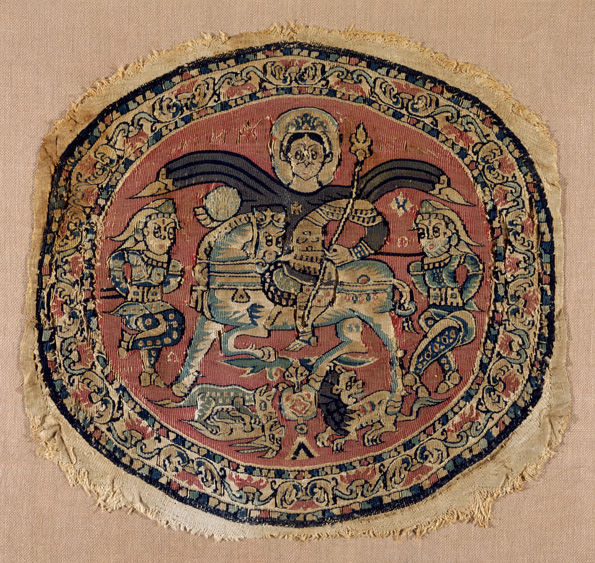Although this exhibition demonstrates how difficult it can be to draw definitive cultural distinctions during periods of transition, certain forms of dress from the period do indicate regional affiliations. The traditional Roman garment was a simple tunic with straight sides. The front and back shared the same dimensions and symmetrical decorations, which often consisted of two vertical stripes running down either side of the neck opening. An Egyptian wall hanging that dates to the fifth to seventh century provides an example of this style, with its two symmetrical figures in the middle of the top row.
Fragments of a Wall Hanging with Figures in Elaborate Dress, 5th–7th century. Egypt. Tapestry weave in polychrome wool. Brooklyn Museum, New York, Charles Edwin Wilbour Fund (46.128a–b)
The upper left section of the same wall hanging includes a male figure in Persian dress, which was a bit more distinctive and more elaborately tailored than its Roman counterpart. Overlong sleeves, flared sides, a rectangular neck opening, an overlapping panel across the chest, and a range of legging types were typical.1 A fifth-century, sky-blue riding coat offers another example.
Persian-Style Riding Coat, 443–637. Stiftung Preußischer Kulturbesitz, Staatliche Museen zu Berlin—Skulpturensammlung und Museum für Byzantinische Kunst, Berlin (9695)
Persian costume also incorporated unique ornamental elements, as seen on a fragment of a wall hanging from the late sixth to early seventh century. The large, central figure, for example, wears a bright yellow cloak with pearl bands around the chest, waist, lower hem, and cuffs. At his waist is a scabbard that most likely, as Cäcilia Fluck suggests in the exhibition catalogue, held a sword. The man on the left wears a blue, belted shirt decorated with hearts and wears a headband with a hanging piece of cloth at the back.2
Fragments of a Wall Hanging with Figures in Persian Dress, late 6th–early 7th century. Made in Eastern Mediterranean. Benaki Museum, Athens
In addition to garment types, embellishments also indicate cultural differences or changes in fashion. The practice of decorating textiles with inscriptions, for example, became widespread under the Umayyad dynasty (661–750).3 These tapestry bands, known as tiraz, indicated the name of the ruler, the producer, and sometimes a date, and they were popular not only among Muslims, but also with followers of other faiths.4 Later textiles become increasingly decorated, featuring more colors and motifs.5
Fragment (detail), 9th century. Egypt. Wool and linen, tapestry woven. The Metropolitan Museum of Art, New York, Gift of George D. Pratt, 1931 (31.19.14)
The image of Heraclius on an eighth-century roundel shows the emperor wearing a crown, a purple cloak, and a jeweled stole. As Helen Evans points out, these elements confirmed his lofty and imperial status.6 (On either side of the emperor, the roundel also depicts two captives in Persian dress with decorative dot patterns embellishing their leggings and coats.) The short tunics in the David plates and the Samson silks suggest youth and virility.
Top row: Roundel with a Byzantine Emperor, Probably Heraclius, 8th century. Made in Egypt, possibly Panopolis (Akhmim). Tapestry weave in red, pale brown, and blue wools and undyed linen on plain-weave ground of undyed linen. Victoria and Albert Museum, London (T.794-1919); Second row, from left to right: Plate with David Slaying a Lion, 629–630. Byzantine. Made in Constantinople. Silver. The Metropolitan Museum of Art, New York, Gift of J. Pierpont Morgan, 1917 (17.190.398, .394); Silk with "Samson" and the Lion, ca. 7th–9th century. Made in Eastern Mediterranean. Weft-faced compound twill (samit) in polychrome silk. Musée National du Moyen Âge, Thermes et Hôtel de Cluny, Paris (Cl. 3055)
The gossamer, "barely there" garments that seem to slip off the hips of dancing women shown on a sixth- to seventh-century ewer clearly represent sexuality, while the dress in the Annunciation silk modestly covers the Virgin, except for her hands and face. Her dress, pose, and the repetitive motif all create a sense of stability and constance. Similarly modest dress appears in the relief showing Stylite monks. The figure on the ladder wears the traditional monastic habit: a long, dark, cotton or wool tunic, an analabos (a type of sleeved vest), a pointed hood, and, most likely, a pair of slippers7
Top row, from left to right: Ewer with dancing females within arcades, ca. 6th–7th century A.D. Iran, Sasanian. Silver, mercury gilding. The Metropolitan Museum of Art, New York, Purchase, Mr. and Mrs. C. Douglas Dillion Gift and Rogers Fund, 1967 (67.10a,b); Annunciation, 8th-9th century. Made in Alexandria or Egypt, Syria, Constantinople (?). Weft-faced compound twill (samit) in polychrome silk. Vatican Museums, Vatican City (61231); Bottom row: Relief of a Stylite Saint, 5th–6th century. Made in Syria. Stiftung Preußischer Kulturbesitz, Staatliche Museen zu Berlin—Skulpturensammlung und Museum für Byzantinische Kunst, Berlin (9/63)
One of my favorite pieces of clothing appears in the Grado ivory fragment. The cross-gartered hose worn by one of the men to whom Saint Mark preaches remind me of Malvolio's stockings in Twelfth Night. But I wonder what these garments meant before the Renaissance, and who was wearing them. Did the gentry of Alexandria wear fancy stockings?
Ivories of the So-Called Grado Chair: Saint Mark Preaching, 7th–8th century. Made in Eastern Mediterranean or Egypt. Ivory. Civiche Raccolte d'Arte Applicata—Castello Sforzesco, Milan (avori n. 2)
Bibliography
Ballian, Anna. "Two Fragments from Fayyum," Byzantium and Islam: Age of Transition, 7th–9th centuries. Ed. Helen C. Evans (New Haven: Yale University Press, 2012), 184–5.
Bruhn, Jutta-Annette. Coins and Costume in Late Antiquity. Washington D.C., 1993.
Evans, Helen. "Roundel with a Byzantine Emperor, Probably Heraclius," Byzantium and Islam: Age of Transition, 7th–9th centuries. Ed. Helen C. Evans (New Haven: Yale University Press, 2012), 15-16.
Fluck, Cäcilia. "Dress Styles from Syria to Libya," Byzantium and Islam: Age of Transition, 7th–9th centuries. Ed. Helen C. Evans. (New Haven: Yale University Press, 2012), 160-161.
———"Fragments of a Wall Hanging with Figures in Elaborate Dress," Byzantium and Islam: Age of Transition, 7th–9th centuries. Ed. Helen C. Evans. (New Haven: Yale University Press, 2012), 166-167.
———"Inscribed Textiles," Byzantium and Islam: Age of Transition, 7th–9th centuries. Ed. Helen C. Evans. (New Haven: Yale University Press, 2012), 183.
———"Persian Style Riding Coat," Byzantium and Islam: Age of Transition, 7th–9th centuries. Ed. Helen C. Evans (New Haven: Yale University Press, 2012), 171.
Fluck, Cäcilia, and Gillian Vogelsang-Eastwood, ed. Riding Costume in Egypt: Origin and Appearance. Leiden, 2004.
Ševčenko, Nancy Patterson. "Costume." The Oxford Dictionary of Byzantium. Ed. Alexander P. Kazhdan. © 1991, 2005 by Oxford University Press, Inc. The Oxford Dictionary of Byzantium: (e-reference edition). Oxford University Press. Yale University. 16 February 2012 http://www.oxford-byzantium.com/entry?entry=t174.e1266
Stillman, Yedida K. Arab Dress: A Short History from the Dawn of Islam to Modern Times. Leiden, 2000.
[1] Fluck, "Fragments of a Wall Hanging with Figures in Elaborate Dress," and "Persian Style Riding Coat," 166–7; 171.
[2] Fluck, "Fragments of a Wall Hanging with Figures in Persian Dress," 28.
[3] Fluck, "Inscribed Textiles," 183. Anna Ballian dates the beginnings to Ibn Tulun's reign (r. 868–84). See Ballian, "Two Fragments from Fayyum," 185.
[4] Fluck, "Persian Style Riding Coat," 171.
[5] Fluck, "Inscribed Textiles," 183.
[6] Evans, 15.
[7] Ševčenko.










